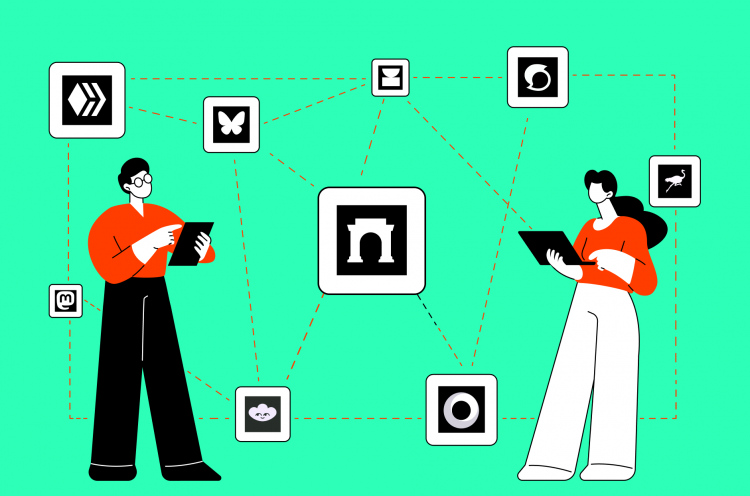I’ve tried six ways to Sunday to monetize content on Social Media. From TikTok to Facebook, I’ve done it all, and it always feels like an uphill battle.
As the founder of an online marketing studio, I managed both my own content monetization and those of my clients. We were managing blogs, newsletters, ads, and SEO. But the tricky trickster platforms are constantly changing their algorithms. There’s a reason you see small business creators upset every time a change is made — it royally screws up our ability to make an income.
The problem with content monetization
Facebook, YouTube, and the rest like to say that it’s easy to make money on their platforms. The primary source is ad placement in your content — except, more often than not, one must meet a minimum threshold of followers or views before monetizing begins.
Viewers can also tip on most platforms, a feature especially well known on TikTok, but the tips amount to pennies on the dollar. It’s no wonder content creators depend on third parties to monetize their content. The social media platforms simply do not compensate well for the content we generate on their platforms.
Try as I might, I became fatigued. I kept running into problems with content monetization. It got to the point where I had to ask: who is actually benefiting from my work? The answer is the social media companies. Without us, they wouldn’t exist. Yet, they treat us like content vending machines, paying us only a fraction of what they make in revenue from our work and depending on their other users to support us.
The average professional content creator waits 6.5 months before seeing any revenue, according to The Tilt. I hated this lead time, for myself and my clients. Over and over, taking on a new client account felt like sleight of hand: “No, really, trust us.” Every time I started a new account, I thought, “Would you work for free for six months?”

How much money do content creators make on social media?
The reality is only 12% of content creators ever make more than $50,000 a year. Much of that comes from influencer deals instead of content monetization via social media opportunities.
This is what set TikTok apart when it launched. Its creator fund set aside $1B which offered real income potential for their users. You could make money on sounds, badges, and video views in addition to tipping from viewers. While those revenue streams still exist today, the fund has been gutted.
Facebook is equally wishy-washy with its payout scheme. Creators make between $1-10 per 1,000 views depending on where they are in the world. No wonder it can take six months (or more) to begin earning — generating 1,000 views on one post takes a ton of work! Getting beyond that milestone is an even greater challenge. But Facebook still earns from the views, regardless of how many.
It’s the same problem that musicians face on Spotify. They get paid a teeny fraction of the revenue for the songs they created and own. It makes no sense!
Discovering Web3 content monetization
To say I was feeling discouraged is an understatement. I felt like the only options for content monetization were corporate and I was doomed to chase my tail. Not to mention most of the platforms continue to publish terms and conditions that favor their ownership of my hard work, including for training AI. What!?
Then a friend pointed me to decentralized social media (DeSoc). It’s way easier to make money on decentralized social media platforms, they said, and my content remains my own. That piqued my interest.
I admit, the fee for some (I have to pay Farcaster $5/year to use it) threw me off at first. Then I realized I was paying to use the service rather than them selling my data and advertising to me. That peace of mind alone is worth $5/year.
By that logic, the various usage fees on other popular DeSoc apps (i.e. Warpcast, DeSo, and Friend.Tech) make more sense.
The earliest decentralized social media platforms required an initial buy-in via NFTs. Lens, instead, charges a small fee for interacting on its platform and creating a profile. Initially, that feels odd: we’re used to getting access to social media for ‘free,’ with our data being the monetizing factor. If I want data security, content ownership, and increased privacy without ads, then I must pay the platform another way.
This is why the creator economy is shifting and Facebook may be losing ground to DeSoc apps. Web3 for content creators feels safer because our data isn’t being sold off from under us, we’re not being advertised to at every turn (or promoting ads to make money), and we own the content we produce and monetize. The difference is night and day (and a huge relief).

Decentralized social media for content creators
How, then, do decentralized social media apps measure up to centralized platforms as income streams for content creators? I was honestly reticent, expecting the hype not to meet the promise. Again, I was pleasantly surprised.
Farcaster, founded in 2020, has nearly 700,000 users. By that number, there are over 600,000 posts per day. That ratio tracks with Facebook, which has 2.9B total users and 2.1B daily users.
But while TikTok made popular the trend of tipping creators, DeSoc platforms took it and ran with it. Lens offers Web3 creators income via tipping in addition to profile NFT sales. The ‘tip’ button holds a prominent place at the bottom of every post.
I put a lot of thought into my professional accounts and would be delighted to be tipped for posts that really resonated with my followers. Not only that, tipping is a much clearer indicator of success than ‘engagement’ metrics (where algorithms are always changing).
Lens is also experimenting with subscription models for content creators similar to Substack. I sometimes plan a topic series for my posts: a subscription would make tons of sense for my followers.
Finally, Steemit, Hive, and Farcaster are all working on token rewards for both posting and engagement on their platforms. The tokens can then be used within their DeSoc ecosystems and for governance participation.
I couldn’t imagine Facebook offering every user the ability to vote on the future activities of the platform. The potential to have a say, especially on changes that could affect my income, means a lot. Web3 for creators like me feels like a no-brainer.
A return to ownership for content creators
After my deep exploration on the platforms and their offerings, I’m in. I’ve longed for full control and ownership over my data, content, and privacy. For me, switching was a no-brainer.
The Onchain research team has a taken a deep-dive into the decentralized social media space. Read the Onchain DeSoc report The Business Case for Decentralized Social Media and Why It Matters Now.
And if you’ve gone DeSoc, here’s where you can find us on Farcaster.



